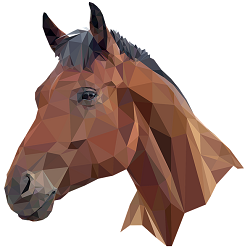
Riding horses is very fun, though not an easy task, and it requires mastering the different techniques involved. The first step to having a good ride is mounting the horse correctly. A proper mount keeps the rider and the horse comfortable during riding. However, it also requires that you apply the proper techniques to get on the horse without toppling over. By learning the appropriate methods of mounting a horse, you will find yourself sitting on the saddle comfortably and ready to ride. This article will understand the components of a horse tack and the step-by-step guide on how to mount a horse.
Components of a horse stack
To understand how to mount a horse properly, we will look at a few components of riding horse equipment known as horse tack. Whether you are a professional rider, a novice, or a beginner, understanding a horse’s features will bring a beautiful experience of mounting riding and dismounting.
Saddles and stirrups: this is the most known part of a horse tack. It is the part that lays on the back of a horse, and this is where you sit. Mostly it is made with leather reinforced with a cushion to make the rider comfortable. Since you will not be sitting directly on the back of the horse, it is designed in a way that lets your weight be equally distributed on the muscles at the back of your horse, making your horse comfortable. All saddles have stirrups. They are permanently attached to the harness, giving you a base to place your leg.
Reins: most reins are strips made of leather, and they are permanently attached to a horse’s mouth on both sides of a harness. The further hang loosely on the neck’s length at a comfortable distance you can always reach. They are mainly used to signal the horse in a specific direction by pulling them.
Bridles: it is the part of your horse headgear. It is designed so that it goes around the nose and jaws and goes over the ear.
Bits: bits pass inside the horse’s mouth and connect with the bridle. They are designed with round metals with small strings attached to both ends. Some are layered with rubber to make the horse comfortable. However, you should always ensure that it is not too tight to avoid injuring the horse.
Horses come in different sizes and breeds ints good to ensure that you have the right horse tack that compliments your horse’s type.
Factors to consider before mounting a horse
Remember to wear boots when riding, especially boots with heels that will enable you to place and maintain your leg ell on the stirrup. You should also wear a helmet and a safety vest in case of a fall.
Check the girth of your horse. The girth is part of the saddle that holds around the chest of a horse. Ensure it is tight enough to keep the saddle in place; however, let it not be too tight to injure the horse.
Make sure to adjust the length of your stirrup. Again, it is advisable to adjust before mounting. The best method is to place your hand on the saddle so that it is perpendicular to the trunk of your body, change them to reach the length of your arm, and extend it to your armpits.
Adjust your reins, and you should be able to hold your reins at all times. You can shorten the rein on the opposite side you will be mounted on.
Step by step guide mounting a horse
STEP 1:Positioning the horse
Walk your horse to a leveled area. Horses tend to be claustrophobic, so it is essential to ensure that they are not cramped. Many people prefer mounting on the left side of the horse. Therefore make sure that side is clear. A rider needs to learn mounting on either side of the horse.
STEP 2: Ensure your mounting block is in place
You may need to have a mounting block to assist you. Move your mounting block into place, preferably under the stirrup you intend to youse to mount. Although mounting blocks are not necessary, they have a few advantages:
first, you will be able to reach the stirrup you intend to use easily.
Mounting without blocks can sometimes strain your horseback on one side; a mounting block reduces the strain while making it easier for you.
Mountain blocks also help train your horse to stay still while you are mounting.
STEP 3: Positioning yourself
Since you are mounting from the left, you should prepare to mount on the left side. Whether you are standing on the ground or using a mountain block, you should position yourself on the left front leg of your horse. At this position, you will be able to reach your stirrup easily without the horse moving. If you are mounting on the right side, the horse’s right front leg is the best position.
STEP 4: Ensure your horse is still
Make the horse relaxed so that it may remain still and not move while you are mounting. Ensure the reins are over the head so that they will be in the correct position when mounting. Then hold them to keep the horse still. For beginners, you can find someone else to have the horse still while you mount
STEP 5: Climbing onto the horse
Holding the reins will help you be able to control the horse in case of any movements. In instances that your horse starts to move, you need to pull gently on the reins. You should be holding the reins with your left hand.
Lift your left leg into the stirrup until the ball is resting on your foot. Your whole body will be lifted eventually. It will be a little easy since you are using a mountain block. If you are mounting From On the ground, the stirrup can be adjusted to a comfortable length then readjusted when you are sitting.
Remember, if you are mounting on the right side, you put your right foot on the stirrup.
STEP 6:Pull your body up onto the horse
Let your body weigh onto your mounting foot and pass your other leg over the top of the horse to the other side of the horse and slip your right leg into the other stirrup. Be careful while swinging your leg not to kick the horse with your foot.
STEP 5: Slowly sit on the saddle
The best way is to gently avoid hurting the horseback as you will create a lot of force when sitting. Ensure both of your feet are on the stirrups before you sit down.
STEP 6: Adjusting your position
When you are comfortably on-site, you can make some adjustments to your sit and posture. Then, check your perimeter correctly and hold the reins ready to go.
Conclusion
Mastering the above steps while paying attention to every detail will make your mounting easy and enjoyable. By mounting correctly, your horse will be comfortable to start riding.
